Protective elements – CZK 5000
| 100 CZK | 200 CZK | 500 CZK | 1000 CZK | 2000 CZK |

A detailed general description of protective elements visible in daylight, with illustrative examples of individual elements on the 2009 version of the 5000 CZK note.
- Watermark
- Windowed thread with microtext
- Coloured fibres
- Front-to-back register
- Latent image
- Colour-shifting ink
- Iridescent strip
- Microtext
1. Watermark
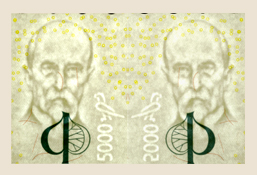
face side reverse side
The watermark is clearly visible when the banknote is held against the light. A “localised” stepped watermark (i.e. a combination of positive watermarks – visible as dark areas – and negative watermarks – visible as light areas – with various shades between the darkest and lightest parts) is used. The watermark is located in the middle of the wide unprinted margin and consists of the portrait of T. G. Masaryk as depicted on the banknote, a negative (white line) 5000 and a sitting eagle.
2. Windowed thread with microtext
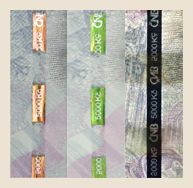
face side through-view
The windowed thread is a strip of metallic plastic, 3 mm wide, embedded into the paper of the banknote. On the banknote’s face side it protrudes in four places from the surface. When the banknote is viewed, only the protruding part of the strip on the face side is visible. When viewed against the light, the whole strip is visible on both sides as a continuous dark line with the recurring hatched negative microtext “ČNB 5000 Kč” showing through. The protruding parts change their metallic colour from puce to green when tilted.
3. Coloured fibres
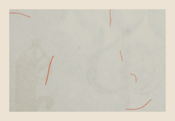
Orange fibres, 6 mm long, embedded in the paper and visible to the naked eye. They can best be seen on the white unprinted margins of the banknote.
4. Front-to-back register

face side reverse side through-view
On each side of the banknote only a portion of this mark is visible. The complete mark, with precisely matching individual lines, is visible when the banknote is viewed against the light. The front-to-back register is a circular mark created by the letters “ČR”.
5. Latent image
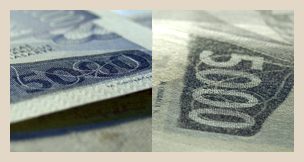
The latent image becomes visible only when the banknote is tipped horizontally at eye level and held against a light source. It consists of figures indicating the banknote’s denomination. When the banknote is looked at transversally (the long side nearer the eyes), a positive (dark) pattern is visible, and when viewed longitudinally (the short side nearer the eyes), a negative (light) pattern is visible. The latent image is located on the banknote’s face side in the decoration on the portrait’s shoulder.
6. Colour-shifting ink
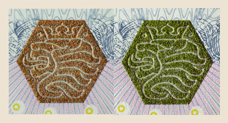
This protective element is based on an optical effect. The colour of the hexagon with the head of the Czech lion printed with special ink changes depending on the position of the banknote when held against incidental light. The colour normally visible on the face side of the note changes colour from gold to green when the note is tipped against the light.
7. Iridescent strip
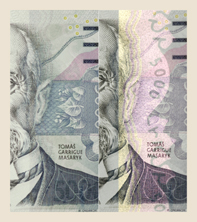
face side against the light
The iridescent strip is about 20 mm wide and located on the face side close to the right-hand margin of the banknote. It is bichrome and patterned from the right. At first glance, it seems to be transparent with a slight ochre hue. When the banknote is tipped against the light, the strip gains a gold and violet hue with a metallic reflection. Negative (i.e. light) figures 5000 and four linden leaves are on the iridescent strip to the right. When the banknote is tipped, the figures and symbols appear dark on the glossy strip.
8. Microtext
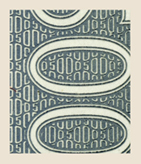
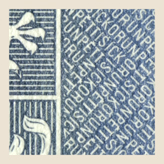
face side reverse side
The microtext is printed in both offset and intaglio printing. On the face side, microtext in the form of figures indicating the banknote’s denomination creates the outline of the large figure indicating the denomination, the internal hatching of the rays below the hexagon with the lion head and the strip of basic colour between the portrait and the right-hand white margin. Microtext in the form of the initials “TGM” creates the hatching of the bichrome ribbon, and microtext in the form of the abbreviation “ČNB” creates its outline in the right-hand part. On the reverse side, microtext is also concealed in the strip of basic colour between the state symbol and the right-hand margin, consisting of words indicating the denomination, and the microtext “PRAHA” is located in the two lower corners.